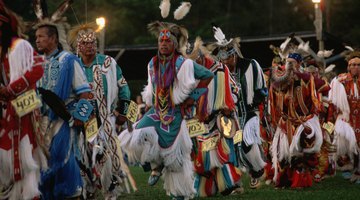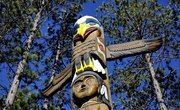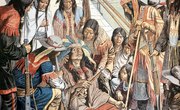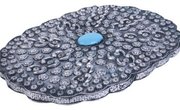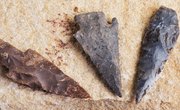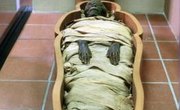Few people can say their family came to America hundreds of years ago. The Caddo have the proud distinction of descending from ancestors who arrived around 700 A.D. These early Indians likely brought with them knowledge of agriculture, pottery, art and hunting from their time in the ancient Mexican empire, as suggested by their advanced civilization. Early Caddo settlements in the United States fanned across many states, predominately the Red River valley, East Texas woodlands, Louisiana, Arkansas and Oklahoma. The Caddo confederacy peaked in 1200 A.D. with 250,000 tribal members. Some earthen mounds made by the Caddo still stand today, revealing mysterious religious rites, pre-Columbian funeral practices and highly structured social organization.
What Are Important Caddo Traditions?
Learning and honoring Caddo traditions helps preserve Caddo history, culture and identity. Revered elders pass down information, tribal customs and legends from one generation to the next. The oral tradition and sacred writings have enabled the Caddo to retain their traditions despite repeated relocation by the U.S. government and European pressure to assimilate.
Drum rhythms and songs date back hundreds of years. The symbolic meanings communicated through traditional dance, song and storytelling teach lessons and impart values. The sacred turkey dance, for instance, has been enjoyed for generations. Women and children dance in a circle while male drummers sing songs in an ancient Caddo dialect. Originally, the turkey dance was done in conjunction with a feast to honor returning warriors. Specific songs sung during the traditional turkey dance tell the story of battles with Apache, Choctaw, Osage and Tonkawa tribes. Today, the Caddo hold turkey dances for fun and socialization.
The Caddo tradition also extends to pottery and basket weaving. Baskets and pots of the early Caddo were not only beautiful and ornate but also functional for gathering seeds, storing grain and cooking meals over an open fire. Mound people like the Caddo needed sturdy baskets for hauling dirt used in the construction of huge earthen mounds. Basket traps were also devised for catching fish in river streams. For a period of time, the Caddo style of artistry was lost. However, Caddo descendants are working to revive this tradition, such as replicating the intricate engravings on coil clay pots characteristic of the early Caddo period.
What Caddo Customs Are Important?
The Caddo were spiritual people connected to nature. Long before the arrival of European explorers, the Caddo were growing corn, cooking in clay pots, building thatched grass houses and hunting game with efficient weapons. It was customary for men to hunt, while women cooked and looked after their children. Families were organized into separate clans, and marriage within clans was unacceptable. Caddo Indians were organized as a communal society, meaning they helped each other with whatever needed to get done. For instance, it was customary for multiple families to work together when building a new house, clearing land, planting or harvesting fields. French and Spanish traders liked exchanging goods with the friendly Caddo Indians, whom they trusted more than some of the more aggressive tribes.
Important Caddo customs include communicating in their native language. Many words and meanings have been lost over the years. The Caddo Nation hopes to keep their endangered language alive through language instruction to children while stressing the significance of speaking the same language as their ancestors.
Traditional Caddo Clothing
Caddo clothing choice varied according to the occasion and season of the year. Everyday attire consisted of practical attire like thick moccasins, breech cloths for men, wraparound skirts for women and tops made from woven plant fibers or animal skins. Buffalo robes kept them warm in the colder regions of the Great Plains. Caddo warriors liked Mohawk hair styles or a shaved head with a long strand of hair flowing from the top of their scalp, adorned with a bright porcupine clip. For special occasions, women wore ribbons in their hair.
Today, people can learn about Caddo clothing and Caddo traditions by attending a lively Native American powwow. In keeping with Caddo traditions and customs, splendid regalia is worn by men, women and children. Colors are dazzling, and shirts are bedazzled with vibrant ribbons. Women wear beautiful beads around their neck and carry beaded shawls with fringe. Although women can be fancy feather dancers, it is usually men and boys who dance in the arena wearing vibrant fancy dancer regalia that includes feathers, intricate bead work and feather fans, for instance.
Were Ceremonies Part of Caddo Religion?
Ceremonies played a significant role in Caddo religious practices. Many important rituals were tied to the annual crop harvest and burial ceremonies that could last days. To ensure the safety and prosperity of their people, the Caddo conducted rituals to please and appease their gods, particularly their chief god, Caddi Ayo. In the Hassinai group of Caddo Indians, a high priest called the Xinesi led ceremonies such as the late summer green-corn ceremony, where the first ears of corn were harvested and offered to the gods.
The Xinesi performed religious ceremonies in structures resembling tall grass huts that were built on top of a huge man-made mound of dirt. Ghost dances were performed to help the living connect with the dead.
The death of a leader was followed by days of ceremony and mourning as the deceased was laid to rest in a burial mound. Excavations of the mounds reveal that up to eight people were occasionally buried together. Archeologists suggest that the bodies may have been family or servants sacrificed by the tribe to honor the leader’s legacy or to provide companionship in the spirit world. Fine jewelry, tools and other precious items were also placed in the grave. The bodies were then covered with wooden poles, grass and a layer of dirt to create a new surface that would be used for the next burial. Some mounds were about the size of an Egyptian pyramid.
How Was Caddo Government Run?
Caddo villages were run by a chief called a “caddi” and elders in a group known as the "canahas." Everyday decisions could be made independently by the chief. Bigger decisions such as declaring war, working on diplomatic relations with other tribes or sharing the peace pipe were made by the chief in consultation with the canahas. Orders of the chief were carried out by appointed enforcers called “tammas.” In early times, women were allowed to serve in key leadership roles. More typically, men were hunters, protectors and decision makers.
When the Europeans arrived, charismatic leaders like Chief Dehahuit proved to be clever negotiators in trade deals and maintained Caddo independence. After the chief’s death, the Caddo lost all their land holdings to encroaching European settlers and were forced onto reservations. Despite these hardships, the Caddo maintained their cultural pride and identity. Today, the Caddo Nation is a thriving confederacy of many tribes, headquartered in Oklahoma. The Caddo Nation operates independently of the U.S. government and provides public services to tribal members.
What Did the Caddo Eat?
The Caddo were hunters, gatherers and farmers. Meat was an important staple in their diet. Using a bow and arrow, men and boys hunted buffalo, deer, birds, rabbits and other small game. The Caddo used flint and other stone tools as knives to prepare their meat and scrape the animal hides. Tribes living along the river bank enjoyed freshly caught fish as well as game. They also put in crops using wooden sticks to plant seeds of maize, squash, pumpkins and sunflowers. Sticks and bones were also used as hoes to weed their crops. Abundant wild berries rounded out the meal. A motar and pestal was used to grind seeds and dried corn that could be stored and used year-round. Food was kept in clay pots safe from gnawing rodents. Favorite meals included meat, fry bread, corn bread, soup and stew. In Texas, the Caddo used salt from salt mines for cooking and food preservation and as a valuable trading commodity.
Related Articles
References
Writer Bio
Dr. Mary Dowd is a dean of students whose job includes student conduct, leading the behavioral consultation team, crisis response, retention and the working with the veterans resource center. She enjoys helping parents and students solve problems through advising, teaching and writing online articles that appear on many sites. Dr. Dowd also contributes to scholarly books and journal articles.

